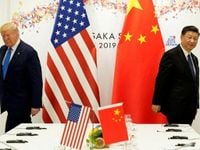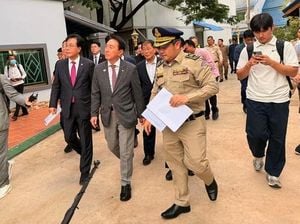South Korea is set to become the epicenter of global diplomacy next week as U.S. President Donald Trump and Chinese President Xi Jinping travel to Gyeongju for a series of high-stakes meetings during the Asia-Pacific Economic Cooperation (APEC) summit. The anticipated visits, confirmed by both Seoul and Washington, underscore the mounting urgency to address regional trade, security, and geopolitical tensions as leaders from 21 Pacific Rim economies converge on the historic Korean city.
According to Seoul’s National Security Office, President Lee Jae Myung will host both Trump and Xi for separate high-level talks, with Trump scheduled to meet Lee on October 29 and Xi on November 1. The APEC summit itself is slated for October 31 and November 1, with sessions focused on strengthening regional trade and economic cooperation. Gyeongju, renowned for its rich cultural heritage and scenic coastal setting, will serve as the backdrop for these pivotal diplomatic engagements.
But the action isn’t limited to the summit venue. The White House has confirmed that Trump and Xi will hold a bilateral meeting in South Korea on the morning of October 30, just ahead of the main APEC sessions. White House Press Secretary Karoline Leavitt told reporters Thursday that the meeting will take place before Trump returns to Washington, though she did not specify the exact venue. According to The Korea Economic Daily, South Korean officials later clarified that the meeting with President Lee would be held in Gyeongju, which is also hosting the APEC summit, while Busan may serve as the location for the U.S.-China summit.
Trump himself has described the planned engagement with Xi as substantial. “We have a pretty long meeting scheduled,” he said Wednesday, responding to questions alongside NATO chief Mark Rutte at the White House. “I think something will work out. We have a very good relationship, but that will be a big one.” Trump added that he hopes the two superpowers can “work out a lot of our doubts and questions.”
This meeting comes at a particularly fraught moment in U.S.-China relations. As reported by Reuters, the two countries are locked in escalating trade tensions, with the U.S. recently imposing a 30 percent tariff on Chinese imports and threatening even higher levies if a deal cannot be reached. Trump has made clear that trade will be front and center in his discussions with Xi, as well as his desire to press the Chinese leader to stop Chinese companies from purchasing Russian oil.
That latter point gained new urgency after Trump’s administration imposed its first sanctions on Russia since his return to the White House. On October 22, the U.S. Treasury Department announced measures targeting Russia’s two largest oil firms, Rosneft and Lukoil, in response to what Treasury Secretary Scott Bessent described as Russian President Vladimir Putin’s refusal “to end this senseless war” in Ukraine. Trump has said he will urge Xi to support these efforts by curbing Chinese purchases of Russian oil.
The diplomatic marathon doesn’t end there. Trump’s Asia tour is packed with stops designed to shore up ties and address a host of regional priorities. He will depart the White House on Friday night, October 24, and land in Malaysia on Sunday morning, October 26, where he’ll meet Prime Minister Anwar Ibrahim and attend the Association of Southeast Asian Nations (ASEAN) leaders’ working dinner. The following day, Trump heads to Tokyo for a bilateral meeting with Japan’s new Prime Minister Sanae Takaichi on October 28. He then travels to South Korea for the crucial APEC summit and a series of bilateral meetings with President Lee and President Xi.
South Korean officials are watching the diplomatic flurry with keen interest—especially the possibility of a surprise meeting between Trump and North Korean leader Kim Jong Un. National Security Adviser Wi Sung-lac told reporters, “We remain open to any dialogue that supports peace and stability on the Korean Peninsula.” Wi also emphasized that the series of summits between South Korea, the U.S., and China would “not only highlight South Korea’s role as a platform but also build consensus for peace, prosperity, and stability in the region.”
Yet not all is smooth sailing behind the scenes. South Korea and Washington remain “at odds” over how to implement a $350 billion investment pledge by South Korea, which is part of a deal to lower tariffs on its exports to the U.S. Industry Minister Kim Jung-kwan acknowledged the ongoing disagreement, underscoring the complex and sometimes contentious nature of the economic negotiations underpinning the week’s diplomacy.
As the summit approaches, anticipation is also building around the broader APEC agenda. President Lee Jae Myung will host sessions aimed at strengthening regional trade and cooperation, with the leaders of the 21 member economies expected to tackle issues ranging from supply chain resilience and digital trade to climate change and inclusive growth. Gyeongju, with its centuries-old temples and UNESCO World Heritage sites, provides a symbolic setting for these deliberations—reminding participants of the long arc of Asian history even as they grapple with the challenges of the present.
For Trump, the whirlwind tour represents both an opportunity and a test. His administration’s tough stance on trade with China and new sanctions on Russia have drawn both praise and criticism at home and abroad. Some observers see his efforts as a necessary push to level the playing field and defend U.S. interests, while others warn that escalating tariffs and sanctions could risk further destabilizing the global economy.
Xi, for his part, arrives in South Korea as China faces its own set of challenges. According to reporting by The Korea Economic Daily, Beijing is navigating “profound” changes and has vowed “rapid” development in its latest five-year plan, even as it contends with slowing growth and external pressures. The Gyeongju summit offers Xi a chance to project stability and engage with regional partners at a time of shifting alliances and economic headwinds.
Meanwhile, President Lee’s role as host places South Korea at the center of the action. By facilitating dialogue between the world’s two largest economies and convening regional leaders, Lee aims to position his country as a diplomatic bridge builder. “Through a series of summits between the leaders of South Korea and the United States, the United States and China, and South Korea and China, we will not only highlight South Korea’s role as a platform but also build consensus for peace, prosperity, and stability in the region,” Wi Sung-lac reiterated.
With the world watching, the coming week in Gyeongju promises to be a showcase for the power—and the complexity—of high-level diplomacy in the Asia-Pacific. The stakes are high, the issues thorny, and the personalities larger than life. But as leaders gather amid Gyeongju’s ancient palaces and modern conference halls, there’s a sense that history may be in the making once again on the Korean Peninsula.




